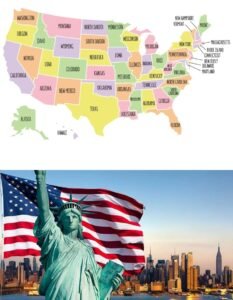Home insurance companies are pulling out of California and Florida, at alarming rates. Earlier this year, State Farm, California’s largest property insurance company, announce It will stop accepting new applications for all property and casualty insurance in the state, citing “historic increases in construction costs that have outpaced inflation, rapidly increasing disaster exposure, and a challenging reinsurance market.” Farmers insurance follows, cover mode About how many policies he writes in the state. And allstatelast year, announce He no longer writes new California homeowner policies.
In Florida, for the past month alone or so, Farmers Insurance has announced that it is withdrawal from the state market In order to “effectively manage risk exposure,” the company said in a statement previously provided to luck. Soon after, AAA said it would not renew “a very small percentage of Florida’s top exhibit homeowner policies,” due to the “challenging market” in the state, according to a statement shared with luck previously.
The situation has become increasingly difficult for the Florida and California housing markets, since both have seen large home price increases during the pandemic. Not to mention that mortgage rates are back on the rise, with last reading For the 30-year average constant rate, it reached 7.37%, hitting a 20-year high. Affordability was shot, and insurance problems only exacerbate the problem. To that extent, according to a survey by John Burns Research and Homebuilder Consulting, insurance concerns are somewhat slowing new home sales in Florida and California.
View this interactive graph on Fortune.com
said Eric Finnegan, vice president of research and demographics at John Burns Research and Consulting luck That they’d heard tales from industry contacts that the struggling insurance industries of Florida and California had an impact on housing markets before they had data to back it up. He said it started with investors looking to buy real estate and get two or three times prices to cover compared to a few years ago. In some cases, they couldn’t justify the cost and those deals fell through. With this survey, John Burns Research and Consulting asked builders how concerned buyers were about the availability and cost of homeowners insurance in their area, and the effect that concern would have on sales, Finnegan explained.
“About a third of Florida homebuilders say buyers’ concerns about insurance availability and costs are slowing sales somewhat,” Finnegan said. luck.
Specifically, 32% of Florida homebuilders say buyers’ concerns about insurance are slowing sales, at least somewhat. But to be clear, in the case of Florida, 68% of builders report no impact on sales. However, in Northern California, 20% of homebuilders surveyed said buyers’ concerns about property insurance are slowing sales somewhat, and in Southern California, 29% of builders said the same. For comparison, nationally, only 9% of builders said insurance concerns were slowing sales somewhat, and in Texas, just 4% said the same.
Obviously, buyers in these markets are worried. In Florida, 54% of builders say buyers are somewhat concerned about the availability and cost of homeowners insurance, and 14% said they are very concerned. And they have a reason for that. Florida homeowners already pay the highest insurance premiums in the country, with an average premium of $6,000 annually, versus the U.S. average of $1,700 annually, according to Mark Friedlander, director of corporate communications at the Florida-based Insurance Information Institute. .
In both markets, insurance operating costs have gone up (although operating costs have gone up in most industries, Finnegan said). In addition, it seems that there are more and more extreme events, whether it is due to severe weather or natural disasters, causing homeowners to file insurance claims. This results in higher costs for insurers, which is why we’re seeing insurers either pull out of these states entirely or renew fewer policies. Residuals can be more selective with who they cover, resulting in fewer options and higher costs for homeowners. Several factors come into play, and these are just two of the many forces behind the exodus of insurance.
Interestingly, Finnegan said, “concerns about costs are keeping people in rental units longer.” For someone who may have been considering buying a home, and has already stretched out their budget to afford the monthly mortgage payments, these increases in property insurance put that out of reach.
Insurance problems may be a secondary concern, Finnegan said, but he still thinks the issue at hand is “serious.” Up to this point, he said, the builders have been able to motivate buyers during Mortgage purchases, for one. The longer rates stay above 7%, the greater the stressful housing affordability insurance issues in California and Florida.
“With mortgage rates still going up, these markets have more risk than, say, Georgia or Texas or Colorado, where these insurance concerns aren’t as prominent,” Finnegan said, pointing to the fact that many potential buyers are already bidding. Wrap their heads around monthly mortgage payments that have more than doubled in just a few years, and high insurance costs make owning a home unaffordable. Perhaps it means that people are continuing to rent for longer, Finnegan noted, or perhaps it means that a family who was going to move to Florida chose not to, or delay their move, instead.
“If these natural disasters, or severe weather get worse, I can see this exacerbating and the impact actually getting worse,” Finnegan said.
The big risk, in his view, is the impact of insurance concerns on housing demand. For California, this could cause more people to move out of the state, Finnegan explained, and for Florida, it could cause fewer people to move there. As we head into the fall, we may see a seasonal slowdown in some markets and “if the insurance issue continues the way it is, or gets worse, it’s going to have a bigger impact,” Finnegan said.
This story originally appeared on Fortune.com
More Fortune:
5 Side Struggles Where You Might Earn Over $20,000 A Year – All While Working From Home
Looking to earn extra cash? This CD has 5.15% APY now
Buying a home? Here’s the savings
This is how much money you need to earn annually to comfortably buy a $600,000 home




